NMPF Officer Tells Congress: Dairy Safety Net Must be Improved in Next Farm Bill
August 04, 2017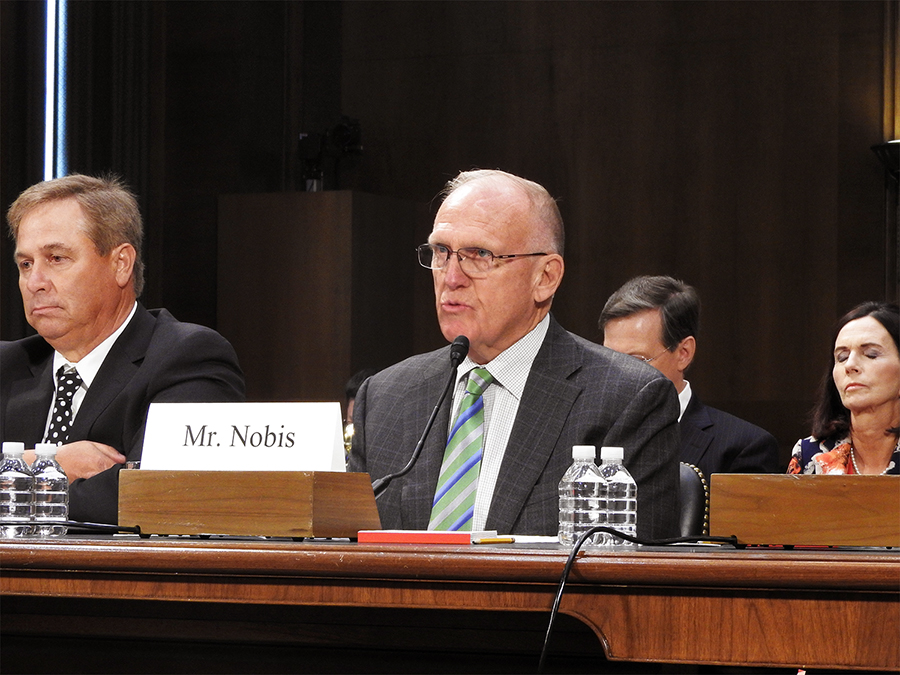 Congress must revise the dairy safety net program first established in the 2014 Farm Bill to provide farmers with more reliable, effective risk management protection, said Ken Nobis, NMPF first vice chairman, at a Senate hearing last month on the future of the Farm Bill.
Congress must revise the dairy safety net program first established in the 2014 Farm Bill to provide farmers with more reliable, effective risk management protection, said Ken Nobis, NMPF first vice chairman, at a Senate hearing last month on the future of the Farm Bill.
Nobis laid out the dairy industry’s concerns with the Margin Protection Program (MPP) at a Washington hearing held by the Senate Agriculture Committee, overseen by Chairman Pat Roberts (R-KS) and Ranking Member Debbie Stabenow (D-MI). Nobis told members of the committee that he believes the MPP is the right tool, but improvements must be made in the next Farm Bill to ensure it works effectively when farmers need it most. A more effective program will lead to increased participation in the MPP, and better overall risk management for the dairy sector.
In addition to his role on the NMPF Board of Directors, Nobis leads the Michigan Milk Producers Association, a milk marketing cooperative serving over 1,700 dairy farmers in Michigan, Indiana, Ohio and Wisconsin. He testified on behalf of his cooperative and NMPF. His full testimony can be found here.
In making the case for improving the MPP, Nobis highlighted proposed changes NMPF and its members have developed to improve it. The MPP is designed to help farmers insure against either low milk prices or high feed costs, Nobis said, but the determination of the feed price used in the margin calculation currently understates the true cost of purchasing dairy cattle feed. During the Farm Bill negotiation process in 2014, NMPF’s original proposal for the feed formula was cut by 10 percent to address budget concerns. Given that the government has profited from the program in years since, the fiscal concerns that led to the 10-percent cut were misplaced, explained Nobis.
“I guarantee, if Congress alters the MPP so that it more accurately reflects the actual costs of production for businesses like mine, participation in the program will increase,” Nobis testified. “Making the program more attractive for dairy farmers is vital to ensuring participation in the program, and the safety of America’s dairy industry.”
Nobis said it is also important to expand dairy farmers’ access to additional risk management tools like the Livestock Gross Margin for Dairy Cattle (LGM) program and similar programs that could be offered by USDA.
Nobis also expressed appreciation to Roberts and Stabenow, as leaders of the Agriculture Committee, for working with Senate Appropriations Committee leaders, including Sens. Thad Cochran and Pat Leahy, to include important changes to the MPP in the agriculture appropriations bill for fiscal year 2018.
The proposed improvements to the MPP would reduce premiums paid by dairy farmers for the first 5 million pounds of milk covered by the program, and change the U.S. Department of Agriculture’s calculation of the actual margin from a two-month average margin to monthly. NMPF believes these developments – which reflect recommendations adopted by the NMPF Board earlier this year – will strengthen the program and help pave the way for additional necessary improvements in the upcoming farm bill.
Nobis’s testimony also touched on several other policy challenges also affecting U.S. dairy farmers, including immigration and labor shortages, the vitality of U.S. dairy trade, child nutrition and environmental sustainability.
Dairy Leaders Highlight Industry Priorities in Separate NAFTA Hearings
August 04, 2017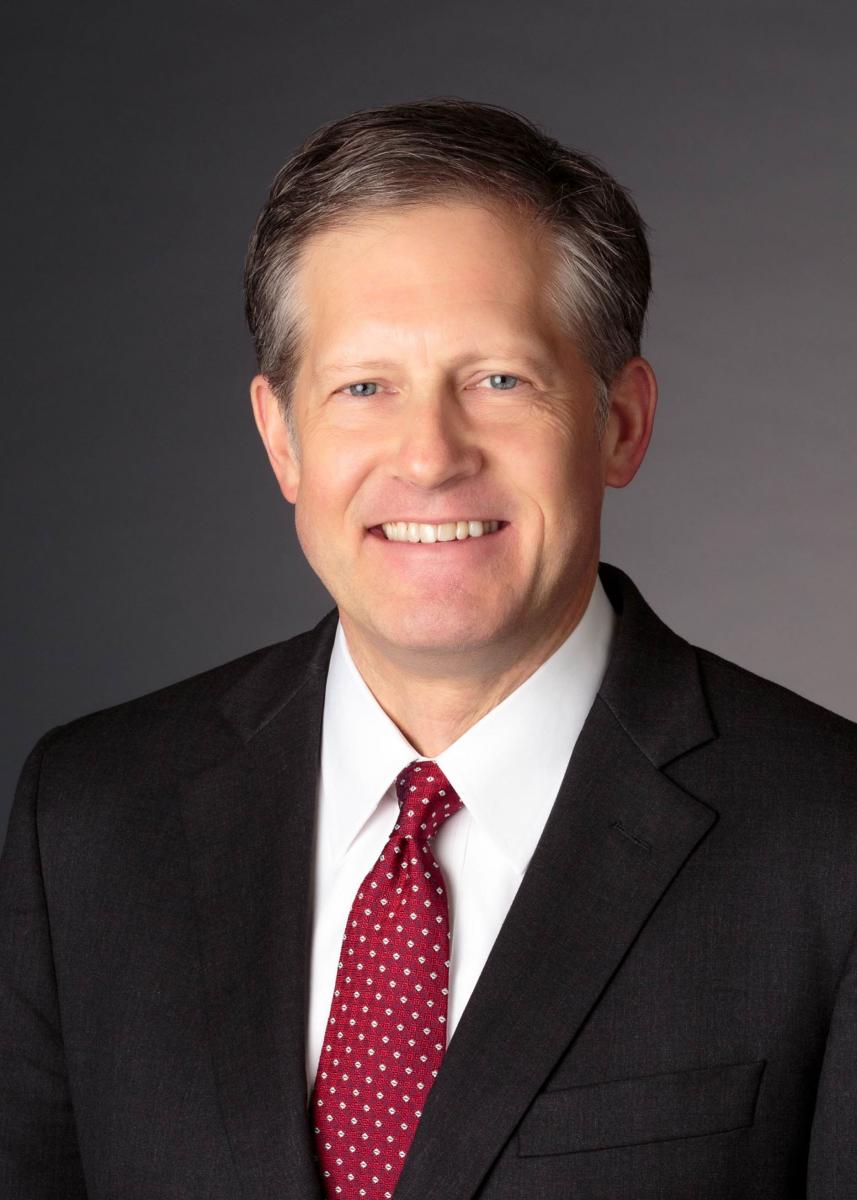 The North American Free Trade Agreement (NAFTA) has been a boon for the U.S. dairy sector, creating jobs and increasing product sales across the country, and any modernization effort should preserve this established success, according to testimonies presented by two top dairy executives last month.
The North American Free Trade Agreement (NAFTA) has been a boon for the U.S. dairy sector, creating jobs and increasing product sales across the country, and any modernization effort should preserve this established success, according to testimonies presented by two top dairy executives last month.
National Milk’s key trade priorities for NAFTA were in the spotlight as both the House Ways and Means Trade Subcommittee and the House Agriculture Committee held hearings on the future of the agreement. NMPF member Darigold was represented by CEO Stan Ryan (pictured right) at the Trade Subcommittee hearing on July 18. Secretary Tom Vilsack, president and CEO of the U.S. Dairy Export Council (USDEC), with which NMPF works jointly on trade issues, subsequently testified before the House Agriculture Committee on July 26. Both Ryan’s and Vilsack’s comments aligned with NMPF’s key trade policy priorities.
They stressed the importance of preserving existing market access avenues under NAFTA and opening up opportunities for new exports through the upcoming NAFTA modernization process, as well as new free trade agreements (FTAs) that are urgently needed in Asia to preserve U.S. competitiveness in that key region.
Darigold’s Ryan told the House subcommittee that his cooperative and other U.S. dairy companies have benefitted from NAFTA through stronger demand for their milk. An agreement that supports more than 25,000 in the dairy sector alone must be preserved, he said.
“NAFTA has been a driving force behind remarkable growth in dairy exports and is the reason the United States’ share today of Mexico’s dairy imports is 73 percent,” Ryan said, adding that U.S. dairy sales to Mexico have risen to $1.2 billion in 2016 from just $124 million in 1995.
Ryan’s testimony also focused on the lack of U.S. dairy access to Canada included in NAFTA, as well as subsequent challenges that have resulted from Canadian policies designed to distort trade. Canada’s new pricing schemes have restricted U.S. dairy protein exports to Canada while also facilitating the disposal of Canada’s excess milk proteins in world markets.
The new Canadian policies “effectively subsidize exports and are already being used to undercut U.S. dairy exports of milk proteins not just to Canada but even more importantly to a number of other export markets around the world,” Ryan said.
USDEC’s Vilsack echoed the need to challenge Canada during his testimony before the Agriculture Committee on July 25. He also stressed the importance of ensuring that the European Union (EU) cannot succeed in its quest to monopolize the use of common food names in Mexico and elsewhere around the world.
“If we allow the Europeans to monopolize certain terms for cheeses, that will make it difficult to market much of what we produce in this country,” he stated.
NMPF President Enforces Dairy Priorities in Meeting with U.S. Trade Representative
August 04, 2017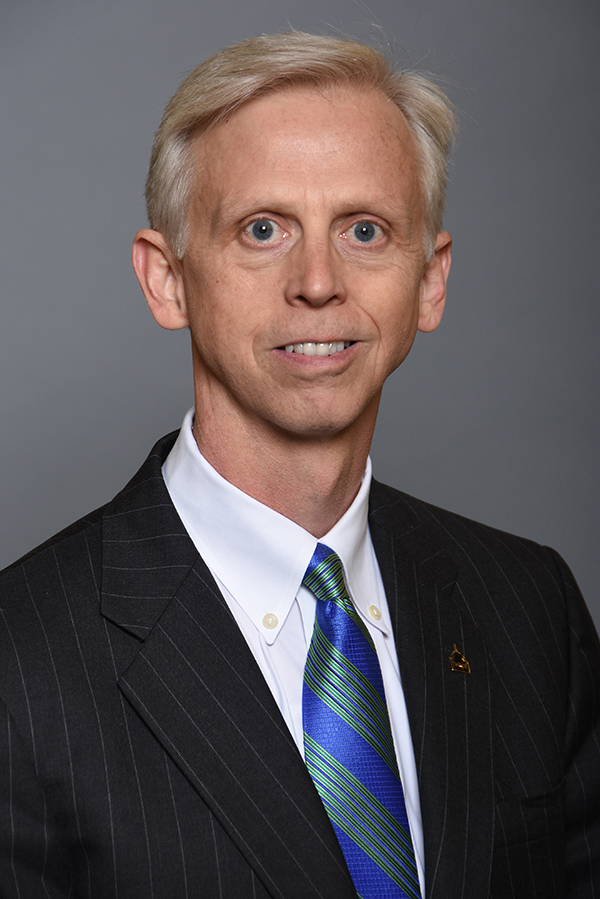 In the final weeks before the United States enters the NAFTA renegotiation process, NMPF President and CEO Jim Mulhern met with U.S. Trade Representative Robert Lighthizer earlier this week to discuss dairy producers’ priorities and concerns on trade.
In the final weeks before the United States enters the NAFTA renegotiation process, NMPF President and CEO Jim Mulhern met with U.S. Trade Representative Robert Lighthizer earlier this week to discuss dairy producers’ priorities and concerns on trade.
Mulhern was part of a roundtable discussion with CEOs of several other leading producer organizations that met with Lighthizer to share a common message of preserving existing trade markets – both in NAFTA and other U.S. free trade agreements (FTAs) – tearing down barriers, and forging new agreements.
In his remarks Tuesday to the administration’s top trade negotiator, Mulhern outlined the dairy industry’s priorities for NAFTA modernization, including the insistence that any future agreement preserve the success U.S. dairy has enjoyed through NAFTA, including its mutually beneficial partnership with Mexico. What should really be addressed, Mulhern said, is Canada’s prohibitive dairy import tariffs, its trade-distorting Class 6 and 7 pricing schemes, and the dispute over geographical indications (GIs).
“While much of U.S. agriculture enjoys duty-free access to Canada, when it comes to dairy Canada maintains insurmountable tariffs of 200-300%,” Mulhern said. “These tariffs must be addressed in the NAFTA negotiations,” he said.
Mulhern added that the global milk powder markets “that our industry relies on will be severely damaged if Canada continues to dump its surplus milk powder on world markets at what are effectively heavily cross-subsidized prices.” “This scenario will drive U.S. farmers’ prices and income to even more depressed levels in the U.S. and around the world.”
Regarding GIs, Mulhern said the United States needs “a stronger offensive strategy” when it comes to protecting names like feta and asiago from being co-opted by the European Union in their trade agreements with countries like China, Mexico and Japan. Allowing this behavior “deals a big blow to our opportunities to expand exports and lower our trade deficit,” Mulhern said.
NMPF Offers Input on Administration Review of U.S. Trade Agreements
August 04, 2017 At the end of July, NMPF provided a detailed assessment of how trade helps grow U.S. dairy sales in response to a call for feedback from the U.S. Trade Representative (USTR) as the administration reviews U.S. trade agreements. NMPF urged the Administration to preserve existing agreements, forge new ones and strongly enforce the terms of deals already in place.
At the end of July, NMPF provided a detailed assessment of how trade helps grow U.S. dairy sales in response to a call for feedback from the U.S. Trade Representative (USTR) as the administration reviews U.S. trade agreements. NMPF urged the Administration to preserve existing agreements, forge new ones and strongly enforce the terms of deals already in place.
U.S. trade agreements are especially positive for America’s dairy producers. “The most advantageous trade agreement partnership that the U.S. has is our open and dependable market access arrangement with Mexico under the North American Free Trade Agreement,” according to the comments, sent jointly with the U.S. Dairy Export Council. “Other U.S. FTAs have also successfully opened up export opportunities for our industry and to date generally worked to the benefit of our sector overall, including those with Central America, Colombia, Korea, Panama, Peru and Singapore, as well as others.”
“To continue that job-creating trend that has benefited dairy farmers and manufacturers alike, our industry strongly encourages the Administration to carefully select and move forward with new FTA partners with key agriculture-importing countries in Asia such as Japan, Vietnam and others in order to keep pace in that growing area of the world.”
The comments also stressed the critical importance of holding trading partners to their commitments to preserve export opportunities for U.S. farmers and manufacturers. Among various trade barrier and distortion concerns, the comments spotlighted Canada’s Class 6 and 7 pricing schemes and the EU’s policies on geographical indications (GIs) to curtail U.S. export opportunities. Further areas of concern included Russia’s and India’s barriers to U.S. dairy exports, among others.
Newhouse Amendment Advances NMPF Proposal to Expand Farmworker Visa Program
August 04, 2017NMPF’s proposal to expand the H-2A farm worker visa program to include the year-round workers needed on dairy farms advanced in Congress on July 20 thanks to an amendment proposed by Rep. Dan Newhouse (R-WA). During a subsequent meeting with Newhouse, NMPF President and CEO Jim Mulhern expressed appreciation for the congressman’s work on the issue.
Rep. Newhouse’s amendment would allow farm employers to use the H-2A visa program to hire foreign workers, regardless of whether those employees are engaged in temporary or seasonal work. Dairy producers largely have not been able to utilize the current H-2A program because it restricts visas only the temporary and seasonal work. NMPF and its Immigration Task Force worked with Rep. Newhouse and Appropriations Committee leaders to develop the proposal so that dairy farmers can use the H-2A visa program to fulfill their year-round labor needs.
“This measure simply broadens an existing program for farm workers to recognize the unique needs of dairying,” Mulhern said. “It is critical to the vitality of the U.S. dairy industry and the fate of thousands of farm workers that our government creates and supervises a system that provides secure, legal employment.”
Expanding the scope of the H-2A farm worker visa program is part of the continuing effort of NMPF and its members to find solutions to the labor challenges facing America’s dairy industry. NMPF’s Immigration Task Force, which represents NMPF member co-ops and state dairy associations, has been working on this issue for many years. In addition to working with Rep. Newhouse and leaders of the House Appropriations and Judiciary committees, NMPF’s immigration efforts have involved extensive outreach to Trump Administration officials in a comprehensive effort to ensure all policy makers understand the unique labor needs of the dairy community.
Mulhern said he is optimistic that NMPF’s work with the House Judiciary Committee will soon result in an agricultural visa program bill, adding that the Newhouse amendment “is a great complement to National Milk’s supportive relationships with other members of Congress to address the need for a legal, reliable supply of farm workers.”
NMPF Tells FDA Regulators to Enforce Rules for Dairy Food Labeling at High-Level Meeting
August 04, 2017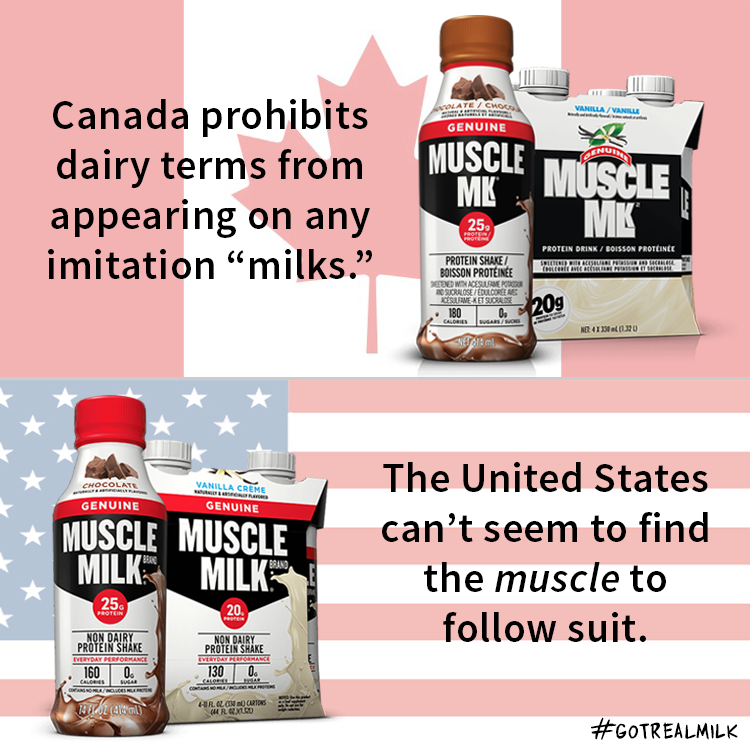 The U.S. Food and Drug Administration’s (FDA) long lack of enforcement of its own food labeling standards has led to a bewildering assortment of nutritionally inferior dairy imitators – a situation that requires immediate action by the federal government, NMPF told the agency at a high-level meeting last month.
The U.S. Food and Drug Administration’s (FDA) long lack of enforcement of its own food labeling standards has led to a bewildering assortment of nutritionally inferior dairy imitators – a situation that requires immediate action by the federal government, NMPF told the agency at a high-level meeting last month.
On July 25, President and CEO Jim Mulhern led a team of NMPF food policy staff to FDA headquarters in College Park, Md., to discuss National Milk’s concern over the agency’s persistent inaction toward the misleading labeling practices of plant-based dairy imitators. FDA standards of identity stipulate that products labeled as “milk” must come from a lactating animal, yet regulators have consistently turned a blind eye to violations of these standards, thereby encouraging imitation dairy manufacturers to inappropriately use that and other dairy terms on their packaging when their products are nutritionally inferior.
“The meeting with FDA allowed us to convey our concern that in the absence of enforcement of existing clear and consistent regulations, well-defined product labels lose their meaning,” said Mulhern. “Cow’s milk has nourished generations, and built a reputation as a natural food with a consistent package of nine essential nutrients. It is misleading and deceptive to allow these nutritionally inferior imitators to use our hard-won reputation to their advantage.”
NMPF executives pointed out that the current federal Dietary Guidelines for Americans admonish consumers that “other products sold as ‘milks’ but made from plants are not included as part of the dairy group [of recommended foods] because their overall nutritional content is not similar to dairy milk.”
“This discrepancy is about more than words,” said Beth Briczinski, NMPF’s vice president for dairy foods and nutrition. “It’s a matter of the public being served nutritionally inconsistent, inferior products that desperately want to ride the coattails of and associate themselves with a superior food.”
NMPF also highlighted how U.S. enforcement of food labeling standards has failed to equal that of countries like Canada and the United Kingdom, where regulators actively police the improper labeling of imitation dairy products. These countries are proof that real milk and milk alternatives can exist without conflict, said Mulhern. “We will continue to press this issue until our government enforces its own dairy standards of identity.”
New House Appropriations Measure Contains NMPF-Backed Dairy Labeling Provision
August 04, 2017In addition to meeting with the U.S. Food and Drug Administration (FDA) last month to urge action against mislabeled imitation dairy products, NMPF has continued its efforts on Capitol Hill to bring pressure against the agency to enforce existing food labeling regulations. The congressional effort gained additional momentum last month with the adoption of a provision calling on the FDA to take prompt action.
On July 12, the House Appropriations Committee approved the fiscal year 2018 Agriculture Appropriations bill, which featured a provision specifying that FDA must enforce federal standards on the use of dairy terms. The inclusion of this language is another success in NMPF’s fight to protect dairy’s good name, and ensure that imitators cannot use terms like “milk,” “cheese,” “yogurt” and “butter.” The appropriations process must conclude by the beginning of October – the start of fiscal year 2018 – and NMPF will continue to work to ensure that this provision is included in any “must-pass” legislative package.
At the same time, NMPF continues to build support for the DAIRY PRIDE Act (S.130/H. R.778), the bicameral, bipartisan legislation introduced by Sen. Tammy Baldwin (D-WI) and Rep. Peter Welch (D-VT) that would require FDA to enforce existing standards on the labeling of products that use dairy-related terms.
NMPF continues to encourage the farmers to contact their elected officials through its Dairy GREAT Action Center and urge support for the DAIRY PRIDE Act.
MPP Forecast: August
August 04, 2017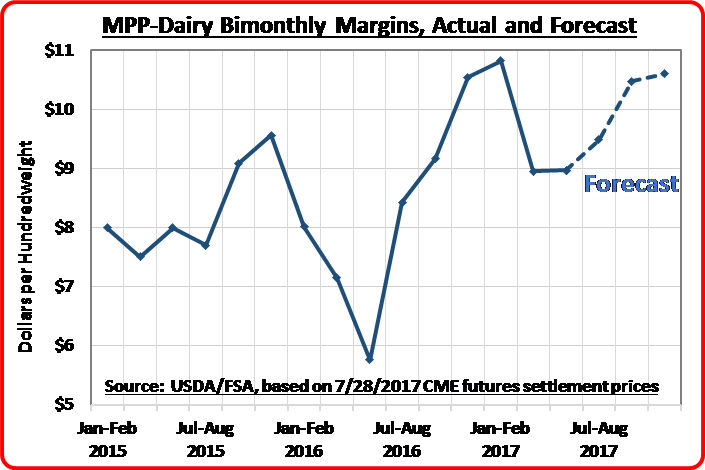 The monthly Margin Protection Program (MPP) feed cost for June was $7.97/cwt, based on corn and alfalfa hay prices reported last week by USDA’s National Agricultural Statistics Service (NASS) and soybean meal prices reported by the department’s Agricultural Marketing Service. NASS also reported that the U.S. average all-milk price rose $0.60/cwt. from May to $17.30/cwt in June. The monthly MPP margin for June was $9.33/cwt, bringing the bimonthly margin for May-June to $8.97/cwt.
The monthly Margin Protection Program (MPP) feed cost for June was $7.97/cwt, based on corn and alfalfa hay prices reported last week by USDA’s National Agricultural Statistics Service (NASS) and soybean meal prices reported by the department’s Agricultural Marketing Service. NASS also reported that the U.S. average all-milk price rose $0.60/cwt. from May to $17.30/cwt in June. The monthly MPP margin for June was $9.33/cwt, bringing the bimonthly margin for May-June to $8.97/cwt.
The monthly all-milk price for June was $0.80 per hundredweight higher than in April, and the same as in March. The current CME dairy futures markets collectively predict that it will add at least another $2/cwt. by the end of this year. The CME futures continue to project modest increases in corn prices and virtually flat prices for soybean meal through the end of the year. The NASS alfalfa hay price dropped slightly from May to June after increasing steadily from $128 per ton in January to $155 per ton in May. USDA’s current MPP margin forecast, shown above, based on the July 28 CME futures settlements, continues to project that the margin will remain well above $8 per hundredweight during 2017, with essentially no chance that it will fall below that level before 2018.
USDA’s MPP margin forecasts are updated daily at online. NMPF’s Future for Dairy website offers a variety of educational resources to help farmers make better use of the program.
CWT Assists Member Co-ops in Securing 4.6 Million Pounds of Export Sales
August 04, 2017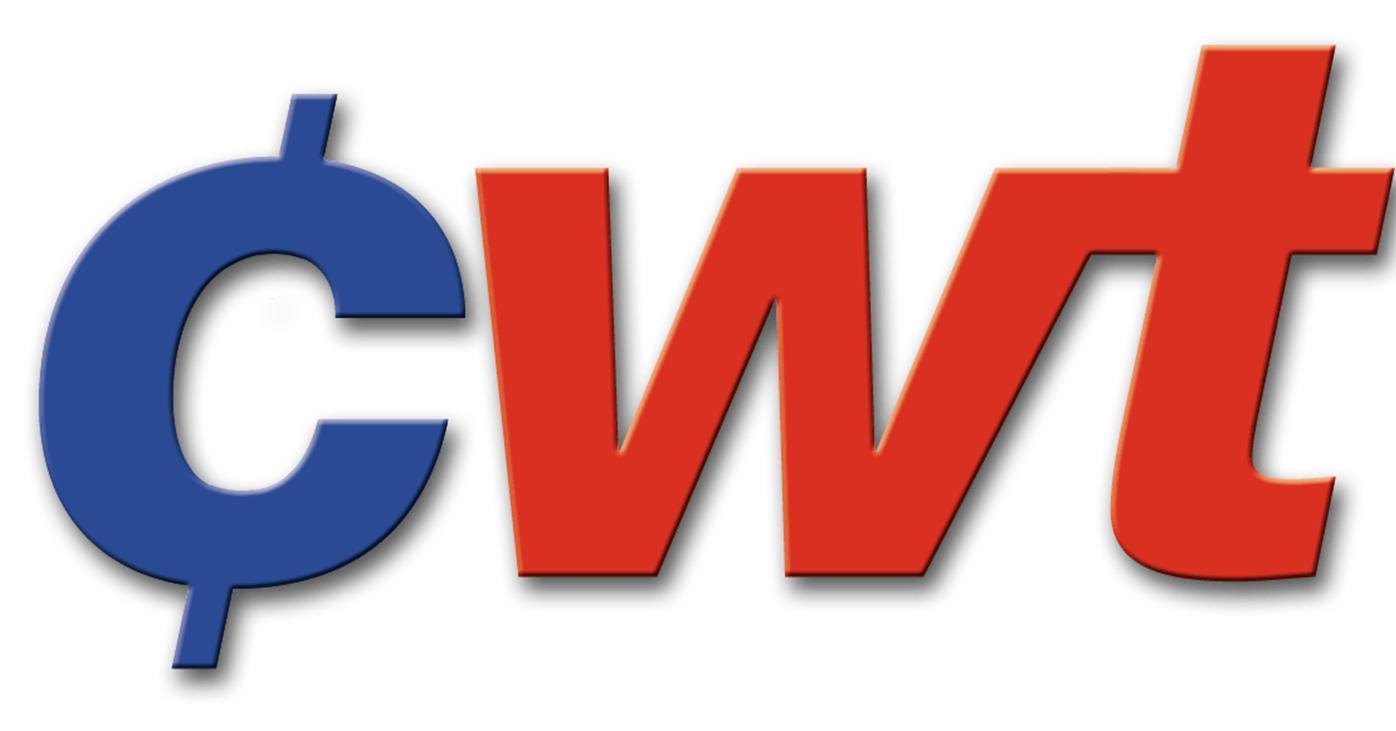 Thanks to assistance from CWT, member cooperatives secured 22 contracts to sell 4.58 million pounds of cheese to customers in Asia, Central America, the Middle East and Oceania in July 2017. The product will be shipped during the months of July through October 2017.
Thanks to assistance from CWT, member cooperatives secured 22 contracts to sell 4.58 million pounds of cheese to customers in Asia, Central America, the Middle East and Oceania in July 2017. The product will be shipped during the months of July through October 2017.
These July transactions raise the total year-to-date, CWT-assisted product sales to 45.04 million pounds of cheese and 3.01 million pounds of butter. These sales are going customers in 17 countries in five regions, and will move the equivalent of 483.47 million pounds of milk on a milkfat basis overseas through October 2017.
In the long term, helping CWT member cooperatives gain and maintain world market share through the Export Assistance program expands the demand for U.S. dairy products and the U.S. farm milk that produces them. This, in turn, positively impacts all U.S. dairy farmers by strengthening and maintaining the value of dairy products that directly affect their milk price.
The amounts of dairy products and related milk volumes reflect current contracts for delivery, not completed export volumes. CWT will pay export assistance to the bidders only when export and delivery of the product is verified by submission of the required documentation.
All cooperatives and dairy farmers are encouraged to add their support to this important program. Membership forms are available on the CWT website.
EPA Requests Stay of Mandate to End Manure Air Emissions Rule Exemption
August 04, 2017The U.S. Environmental Protection Agency (EPA) filed a motion with the U.S. Court of Appeals on July 17 to halt issuance of a mandate to eliminate the manure air emission exemption for six months from the date of a stay order or until Jan. 17, 2018, whichever is later. In the meantime, NMPF continues to engage with senior EPA staff and members of Congress to find a long-term solution.
EPA stated that a stay is needed in order to give the agency time to develop guidance for farms on how to measure emissions of hazardous substances from animal waste in order to report releases of the substances exceeding threshold levels in compliance with the Comprehensive Environmental Response, Compensation, and Liability Act (CERCLA) and Emergency Planning and Community Right-to-Know Act (EPCRA).
EPA noted that 63,000 small- and medium-sized farms that were previously exempt from the reporting requirements must come into compliance. EPA also conveyed to the appeals court that they intend to explore possible regulatory or other administrative approaches to address reporting obligations. A favorable ruling on EPA’s motion will cut off any potential litigation and give NMPF time to collaborate with EPA and animal agriculture industry partners to find a long-term solution.
Revision Continues of WOTUS Rule Opposed by NMPF
August 04, 2017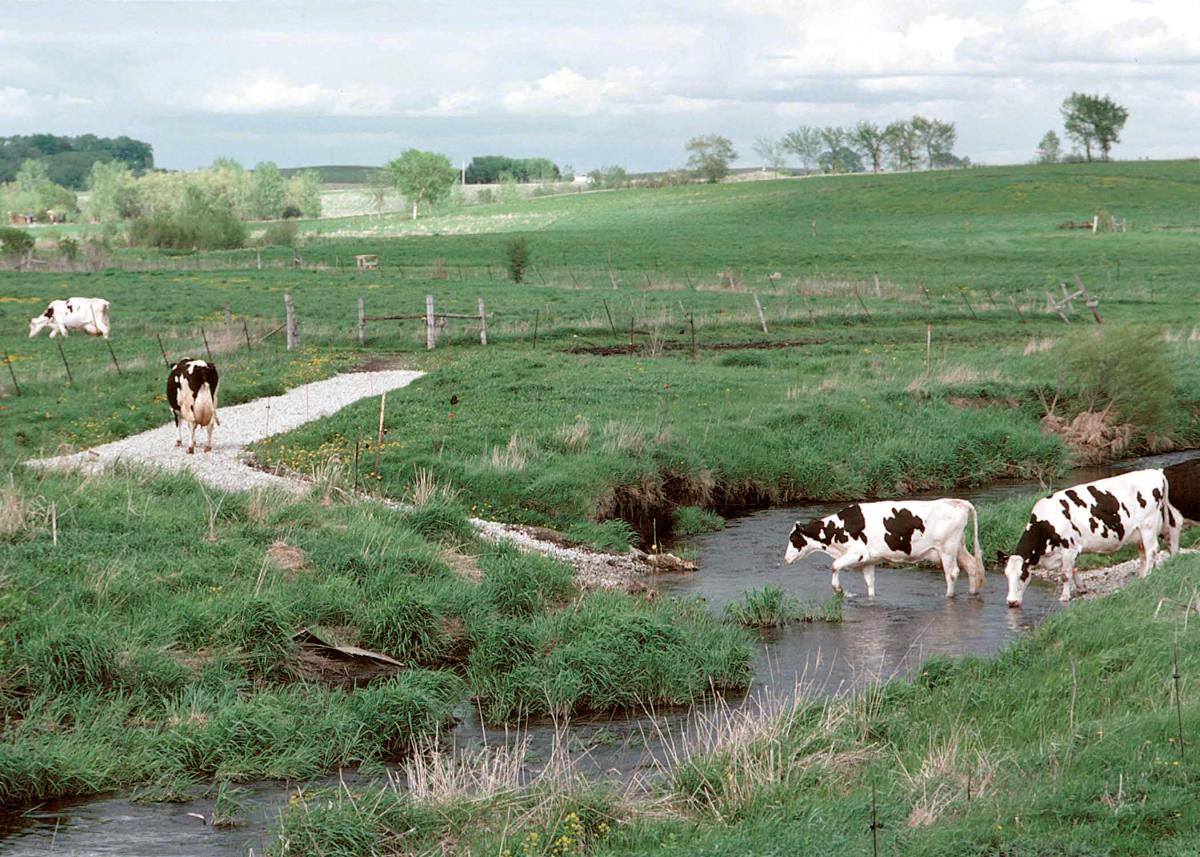 In a welcome development for NMPF and other farm groups concerned with the flawed Waters of the U.S. (WOTUS) regulation, the U.S. Environmental Protection Agency (EPA) and the Army Corp of Engineers last week formally began the process of withdrawing the controversial 2015 regulation. NMPF intends to file comments in support of EPA’s plan to rescind the rule, and will continue to engage with EPA as a second, revised regulation is issued later this year.
In a welcome development for NMPF and other farm groups concerned with the flawed Waters of the U.S. (WOTUS) regulation, the U.S. Environmental Protection Agency (EPA) and the Army Corp of Engineers last week formally began the process of withdrawing the controversial 2015 regulation. NMPF intends to file comments in support of EPA’s plan to rescind the rule, and will continue to engage with EPA as a second, revised regulation is issued later this year.
Earlier this year, the incoming Trump Administration ordered a review of the WOTUS rule in response to concerns many farm groups had raised since the measure was finalized in 2015. Because the WOTUS regulation significantly expanded the EPA’s authority over waterways used by farmers for drainage and irrigation, the measure was challenged in a federal appeals court and ultimately put on hold last year.
This latest development on July 27 is part of a plan outlined this spring by EPA Administrator Scott Pruitt to initiate a public rulemaking to rescind WOTUS, and in the interim, revert to following laws governing water protection that were first enacted in 1986. NMPF agrees with the EPA that the agency needs to proceed in this manner.
EPA will accept comments on the rescission of the 2015 WOTUS rule until Aug. 28, 2017. This winter, EPA will issue a proposal to modify the 1986 rule so that it focuses on a logical and reasonable interpretation of the Clean Water Act and related judicial opinions.
NMPF Ensures Processed Cheese Standard Discontinued, Leads Other Dairy Successes at Codex Meeting
August 04, 2017NMPF’s participation helped resolve several key issues at the Codex Alimentarius Commission (CAC) meeting in Geneva, Switzerland in early July. The issues included a long-deliberated standard on processed cheese, work on new standards to combat antimicrobial resistance, as well as discussions about Codex’s overall scope of work and authority, and elections of a new Codex Chair.
NMPF staff attended the meeting as part of the U.S. delegation, with support from the U.S. Dairy Export Council, to ensure that these issues — and others — were resolved favorably for the dairy industry. The standard on processed cheese was one that had challenged the Codex Committee on Milk and Milk Products (CCMMP) for decades. NMPF has long asserted that such a standard is unnecessary, but work on the standard has continued in Codex due to an on-going request by many developing countries in Latin America and Africa.
This year, notwithstanding objections and reservations from numerous countries, the Chair of the Commission stood firm that the recommendation of the Codex Executive Committee to discontinue work should be respected, as there had been no proposed solutions or ways forward over the past year.
The most critical discussions at this year’s CAC meeting focused on the topic of antimicrobial resistance. The Codex Commission formed two working groups to develop and revise standards to address this issue: one on Practice Revision and another on Surveillance. NMPF staff worked to ensure that the scope of both working groups is as limited as possible, and fully supported the U.S. efforts to chair the Practice Revision working group. The Netherlands will chair the working group on Surveillance, and NMPF will be represented on both working groups and actively engaged in this work going forward.
The Commission also adopted the Codex Standard for Dairy Permeate Powder, which had been under development in recent years and was strongly supported by the U.S. dairy industry. The Commission agreed that the work related to use of preservatives and anticaking agents for surface treatment of Mozzarella with high moisture content should be addressed through the Codex Committee on Food Additives (CCFA).
Lastly, the Commission elected a new Chair, Guilherme Antonio da Costa Jr. from Brazil, and three new Vice-Chairpersons from Indonesia, Lebanon and the United Kingdom. The U.S. government was pleased with the outcome of the election, and NMPF staff will now be working to ensure that the U.S. forms a strong relationship with the new chair, in order to ensure the most favorable resolutions of our issues during his three-year tenure.
A copy of the full CAC report can be found here.
FARM Program Hosts More than 70 at Second Annual Evaluator Conference
August 04, 2017NMPF’s second annual FARM Program Evaluator Conference held last month hosted more than 70 dairy industry experts to share, network and learn about the latest in animal care, environmental sustainability and antibiotic stewardship efforts. Elanco, Zoetis and Merck Animal Health sponsored the event, held July 18-20 in Indianapolis.
FARM evaluators were able to hone their professional development and leadership skills at this year’s event. Later they were given a tour of the Elanco headquarters, where they learned about the company’s mission, goals and role in the social responsibility conversation.
The next day was packed with programming on topics ranging from “The Economic of Animal Well-Being” with Dr. Ricardo Chebel from the University of Florida, to a presentation on proper pain management during disbudding with Dr. John Laster from Todd County Animal Clinic. One of the most compelling sessions was a panel discussion of farmers and Merck Animal Health staff sharing the importance of employee training and protocol development — key elements in version 3.0 of the FARM Animal Care Program.
An optional tour of Fair Oaks Farm rounded out the week, hosted by NMPF Third Vice Chairman Mike McCloskey and his family. Experiencing “Dairy’s Disneyland” allowed the attendees to learn the value of telling the good dairy story. Dr. Tom Sarosy, of Prairie’s Edge Dairy and Fair Oaks Farms, joined the group for lunch to discuss Fair Oaks’ philosophy on what makes a successful working environment to enhance animal welfare.
FARM Program to Host Programming at AABP Conference in September
August 04, 2017In September, the National Dairy FARM Program is joining the National Beef Quality Assurance Program to host a half day of programming at the 2017 annual conference of the American Association of Bovine Practitioners in Omaha, Neb.
The meeting on Sept. 14 features several sessions that will focus on emerging animal care issues within the dairy industry. These include topics like the veterinarian’s role in crisis management and the release of the National Beef Quality Audit results. Speakers will include Dr. Nigel Cook of the University of Wisconsin School of Veterinary Medicine and Dr. Hans Coetzee of Kansas State University College of Veterinary Medicine. More information can be found on the AABP website.






